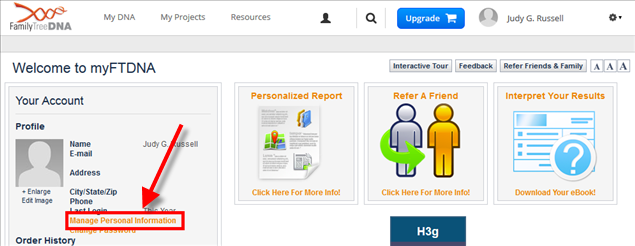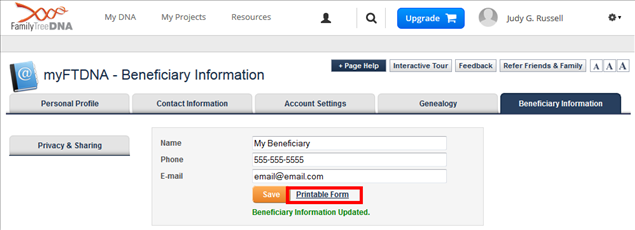Something to plan for
So the question came up more than once yesterday when The Legal Genealogist and the Chicago Genealogical Society together explored the uses of DNA in genealogical research at the Arlington Heights Memorial Library:
Who owns your DNA sample when you submit it to a testing company?
There’s really no doubt about the answer: you do. For example, Family Tree DNA says flatly, “DNA samples belong to customers.”1
In fact, you can’t — that is, you’re not supposed to — even submit a sample for testing unless it’s yours or that of someone for whom you have legal authority to act.
All four places where I’ve currently tested — 23andMe, AncestryDNA, Family Tree DNA and National Geographic’s Geno 2.0 project — require that the sample be submitted by the person whose sample it is or by someone with the legal authority to consent for that person (such as a parent or guardian on behalf of a child). For example:
• Family Tree DNA explains, repeatedly, in a number of contexts, that “Even if you paid for the test of a friend or relative, they need to be the one to consent … we ask that you practice ethical testing and kit conservatorship…”2
• 23andMe’s terms of service require that “You are guaranteeing that any sample you provide is your saliva; if you are agreeing to these TOS on behalf of a person for whom you have legal authorization, you are confirming that the sample provided will be the sample of that person.”3
• At AncestryDNA, “you represent that any sample you provide is either your DNA or the DNA of a person for whom you are a legal guardian or have obtained legal authorization to provide their DNA to AncestryDNA.”4
So ownership isn’t really the question, is it? The real question is, who can access our data if something happens to us? Or, more importantly for folks like me who’ve paid for dozens of cousins to test, do I still have permission — do I still have the right to continue to access a cousin’s data if something happens to that cousin? Can I order an additional test done?
One company makes it really easy to have an answer to that question, and I wish the others would follow suit.
You see, Family Tree DNA lets each of us choose and specifically identify a beneficiary for our kits. By simply filling in a few bits of information, and getting one piece of paper properly notarized, I can set things up so that someone I choose can be:
the sole beneficiary to (my test kit), my Stored DNA, DNA Results, and Family Tree DNA account, to do all things required. For that purpose my beneficiary may execute and deliver, or amend, correct, replace all documents, forms, consents or release, tests and upgrades, and may do all lawful acts which may continue my involvement with FamilyTreeDNA.com.5
Here’s how to do it. First, log in to your FTDNA test results. Look on the page for this link to Manage Personal Information:

Click on that link, and you’ll go to this page with these tabs, and note the one highlighted at the right:

Click on the tab for Beneficiary Information and this is what you’ll see:

And when you fill out those boxes and click save, it will offer you the chance — highlighted here — to go to a printable form, already filled out with the information you entered in the boxes.

That form needs to be notarized. I keep a copy with my will. I’ve sent a copy to the person I’ve chosen to be executor of my estate.
And, I’ll tell you, I’ve done one thing more, since neither 23andMe nor AncestryDNA offers the same easy system.
I’ve taken the Family Tree DNA form, and changed the language, replacing all the references to Family Tree DNA with each of the other company names, and all the references to my kit number and the like with appropriate information about my test results from the other companies. And I’ve given my beneficiary the legal authority to continue to access my results and accounts at those other companies if something happens to me.
Now I can’t guarantee the other companies will honor that authority, because they haven’t been as forward-thinking as Family Tree DNA is about this issue. But it’s the best I can do until and unless the other companies do set something up on their own.
Because if something does happen to me, it may well be more important to my extended family to have my genetic legacy as any other legacy I might possibly leave them.
So I’m doing everything I can, with Family Tree DNA’s help, to ensure that that legacy does get passed on.
SOURCES
- “The Family Tree DNA Learning Center BETA: Sample Access and Transfer Policy,” Family Tree DNA (http://www.familytreedna.com/ : accessed 13 Sep 2014). ↩
- Ibid., “I paid for a relative’s test, may I contribute their results to science?.” ↩
- “Terms of Service: User Representations,” 23andMe (https://www.23andme.com/ : accessed 13 Sep 2014). ↩
- “US Terms and Conditions – Revision as of March 20, 2013: DNA Testing,” AncestryDNA (http://dna.ancestry.com : accessed 13 Sep 2014). ↩
- FTDNA beneficiary designation printed form, Family Tree DNA (http://www.familytreedna.com/ : accessed 13 Sep 2014). ↩



Great information, and thanks for the good advice, Judy. Have you heard anything regarding the disposition of Ancestry’s DNA database?
There’s been no change in their plans, Tom, I regret to say.
Thanks for addressing this topic. It is certainly something to think about & I hope the other companies will address this issue.
Thanks for the info. This made me think about those of us who ordered & paid for a dna test for a relative because (1) they could not afford it, (2) they would not take the test without strong encouragement — I bought this dna test for you to take it so I can further my genealogy research.
We all do need to make sure those relatives take care of this designation!!
Oh my goodness, I am going to do the same, thanks Judy! I have tested with the same companies.
Glad it helped you, Shelley!
I have taken about 24 DNA samples from my many cousins, here in California, Minnesota, Florida, and New York.
I paid for all the testing at familytreeDNA. They all signed a release form allowing me to collect their DNA. Should I expect and problems in the future?
Expect them, no. Plan for them, why not? Making sure each one gives you a beneficiary designation will avoid any possibility of potential headaches in the future.
Thanks
OK. Of course I have to be the one to throw the curve ball. LOL What about a situation like the one that happened with Henrietta Lacks and the HeLa cells that have sense been replicated, for decades? After reading that book, it made it seem as though anytime you give a sample, be it DNA for genealogy or for other medical reasons, your transfer ownership over to the hospital or entity that is doing the testing and that by virtue of you leaving your “goods” there, they now own them. Or, at least they can argue this. Since FTDNA has this spelled out well, I don’t think they subscribe to this, but what about the other companies? For those not familiar with Henrietta Lacks, I highly suggest reading The Immortal Life of Henrietta Lacks by Rebecca Skloot. Amazing book.
Henrietta Lacks was an extraordinary case: one that is disturbing, for sure, but extraordinary nonetheless. She was a medical patient who had surgery and the cells involved were removed during the surgical procedure. The law in her jurisdiction made such items, technically, medical waste. It is NOT the same as giving a DNA sample to a company subject to that contract. But yes, read the terms of the contract with the testing company carefully because some DO have provisions giving the company the right to aggregate your data — anonymously — with that of others for research purposes, including commercial research.
Thank you for this suggestion, Judy! A few of us on the Ancestry-Gedmatch-FTDNA-23&me-Genealogy and DNA Facebook page were just wondering whether FTDNA has provisions for a beneficiary following our deaths. We can each designate a beneficiary for our own kits, but what is the best way to do that for the kits for which we have been designated beneficiaries? Perhaps we could draft agreements similar to the ones that you did for the other services, but specify that this is for the transfer of the kits for which we have been made beneficiaries, but would this hold up legally? I notice that in 2012 you wrote that you’ve added contingency beneficiaries to your forms. Is there particular language that you would recommend to ensure that this holds up legally? https://legalgenealogist.com/blog/2012/03/04/who-owns-your-dna-test-results/
The key language would be for the original kit donor to indicate that the designation of beneficiary was to you and anyone designated by you as a contingent beneficiary in the event of your death, and then name the contingent beneficiary in your own statement.